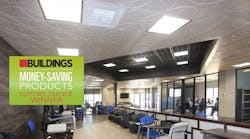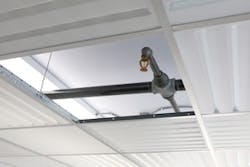Ceilume’s innovative ceiling panels were one of just three products to win the Editors’ Choice designation out of the 45 Money-Saving Product winners. See why these thermoplastic panels wowed our judges.
Rather read the transcript?
[Start transcript]
Janelle Penny: Hi, this is Janelle, Editor-in-Chief of BUILDINGS magazine. And I’m here with Ed Davis. He’s the president of Ceilume and their product, the Ceilume ceiling tiles, were one of the three Editor’s Choice winners in our Money-Saving Products Awards this year. Ed, thank you so much for joining me.
Ed Davis: Janelle, it’s a real pleasure to be doing this.
Janelle: Great. So, tell me a little bit about the product. How does it work?
Ed: Suspended ceiling tiles is a product category that’s been around about 70 years, and they came into being because people wanted a way to conceal all of the infrastructure stuff that often is hanging from a structural ceiling.
It was an easy way to do that. A suspended grid is dropped down and then panels usually of two-by-two foot or two-by-four foot size are dropped into the grids so it gives you access to that area above the ceiling grid without having to do all the structural work of a full ceiling below it.
Janelle: Great. Now what are some of the challenges with maybe a conventional suspended ceiling grid that would be solved by the Ceilume tiles?
Ed: Well, the—everybody is familiar with the sort of industry standard ceiling tile, which is made of mineral fiber, you may be sitting under one right now. They’re kind of chalky looking. Some people describe them as being like cottage cheese. And one of the big challenges that particularly building maintenance folks face is that they ugly out really quickly. They tend to be soft, they stain easily. If you have a building that has a water leak anywhere and almost every building does, you see these nasty water stains on them. So what our tile does is essentially eliminates the problems associated with mineral fiber.
Ours are very flexible. So, unlike the mineral fiber tiles that crack easily, you often see them with their corners broken. Ours are very flexible so you can easily put them in and put them out of tight spaces with no worry about them cracking or breaking.
From a maintenance standpoint, one of the reasons you have a suspended ceiling is so you can get up into that area above it. You’ve got to work on HVAC, you’ve got to do maintenance of various times. The tiles are put in and out quite a lot.
With mineral fiber when you’re putting those things in and taking them out, all sorts of nasty things happen. They’re very friable, so you get a lot of dust. They’re easy to break, of course. They’re not very good for indoor air quality because they hold mold and mildew and they absorb moisture. So, ours do none of that.
We actually had a round of testing done just lately designed to compare one mineral fiber ceiling tile to another and it tests hardness, flexibility, sag and pliability. And it turns out we were an order of magnitude that’s 10 times better in each category than mineral fiber. So, that’s one of the things that really solves problems for folks in building trades.
You can clean them. With a mineral fiber tile, if it gets stained, your choice is to replace it. And unfortunately, all of us have seen this. Most people don’t, most people don’t replace them. They tend to sort of ignore that ceiling space above them. And it doesn’t take very long for a ceiling to get really ugly. Ours are impervious to water. They’re great for building resilience and survivability, you can actually take them and dunk them in water and they’re just fine. They’re not affected by it at all.
The color on our colored tiles is not just skin deep. With a mineral fiber tile if you scratch it and scratch through the finish, and you’re now back into this nasty chalky stuff inside of it. Ours are the same color all the way through.
From an installation and maintenance standpoint, they’re really easy to handle and really safe. If you look at the safety warning on the standard mineral fiber tiles it will scare you to death. It’s like you’re supposed to be dressed in a body suit, with protective gloves and respirator all of this stuff. These don’t require any of that.
Janelle: Great, so kind of on that same tack, how does this product save money?
Ed: Well, many, many ways. One of them is to, you know, to walk in on the ease of installation. They’re just really easy, no special equipment required and they’re really lightweight.
They’re about 20% of the weight of a standard mineral fiber tile. Getting them up and down on ladders, reaching to install them easily done by one person rather than two.
They’re five times more efficient to ship because of they use only 20% of the raw material than mineral fiber tile does. They ship much more densely. They don’t break, they don’t crack. They don’t need to be conditioned, which is a big thing, particularly for new buildings, you’ll often see that the material needs to be taken into the space and “conditioned,” quote unquote, for 46 or 72 or 96 hours prior to installation. Ours don’t require any of that.
They’re very highly light reflective. So they’re really good for lighting efficiency. They help you downsize your luminaires but still not lose that sense of a good light in space.
A big one that’s unique to us is that they allow you to install the tiles below fire suppression sprinklers.
Janelle: Great. What are some of the other features that set it apart from the other competitors in this field? Can you talk a little bit about what makes this unique or interesting, in addition to what we’ve already been discussing,
Ed: Well, actually I’ll build a little bit on the fire sprinkler advantage. Our tiles are designed to install below sprinklers and think of a minute about what that means in a fire sprinkler building.
You don’t have to drop the sprinkler through the tile, you don’t have to have a finished escutcheon or appearance sprinkler.
So for instance, in a building that already is sprinklered, say a manufacturing area or warehouse, if you want a better looking ceiling or, for instance, if you’re doing food processing or manufacturing of some sort, and you’re required to have a ceiling that meets health standards for cleanability. You can put a grid in and install our tiles below that sprinkler system without having to change it at all.
We had a recent case where a granola manufacturer back in the northeast did exactly that. They’re moving into an existing space. Has sprinklers already and the Health Department said you can’t have these sprinklers exposed the way they are. What are you going to do? They found us.
It turned out that the cost of putting in our whole ceiling was less than it would have been for them to adapt to the sprinklers to meet the health standard. So, that’s a big one.
Other things that set us aside is we’re really pretty. I don’t think anybody has ever described a mineral fiber tiles as being pretty. We got beautiful colors and finishes, metallic finishes, woodgrain finishes, about 40 different styles that fit sort of every era. We also offer our styles in transluminous material, meaning various grades of translucence which allows you to put lighting fixtures above.
It’s a great way to save money because you’re not using expensive fixtures. But it also allows this wonderful illuminated ceiling look so you kind of don't get shadows in the corners sort of light everywhere, which is very, very cool.
The things we do that others don’t, we have a special insulation that we sell we go on top of the tiles if folks want to improve their R-value or NRC. It’s made of polyester, so it doesn’t itch then scratch like standard insulation.
We offer grid covers. One of the things that happens when the old mineral fiber tiles are getting ugly, often the grid they’re in is getting ugly, too. We have designed the simplest means of using a snap on cover that will make the grid look like new and make it look as good as the new tiles you put in.
I guess finally, we’ve been at this a long time. I was looking this up just lately and the original company that morphed into Ceilume was founded in the late 1940s, and holds one of the earliest patents about modular ceilings.
We had a call and nice interchange with a customer about a month ago who had gotten to us and said hey, I have had these ceilings in my house for 50 years. Can I still get them? They sent us back a ceiling tile, 50-year-old tile that still looked and worked just fine, but they wanted to upgrade to another one. So, that was pretty cool.
Janelle: Awesome. Well, Ed, thank you so much for joining me today. This has been really illuminating.
Ed: Great, great. Glad to do it.
Janelle: Great, and thank you all for listening today. We’ll see you next time.
[End Transcript]
Check out the other 2020 Editors’ Choice winners:



